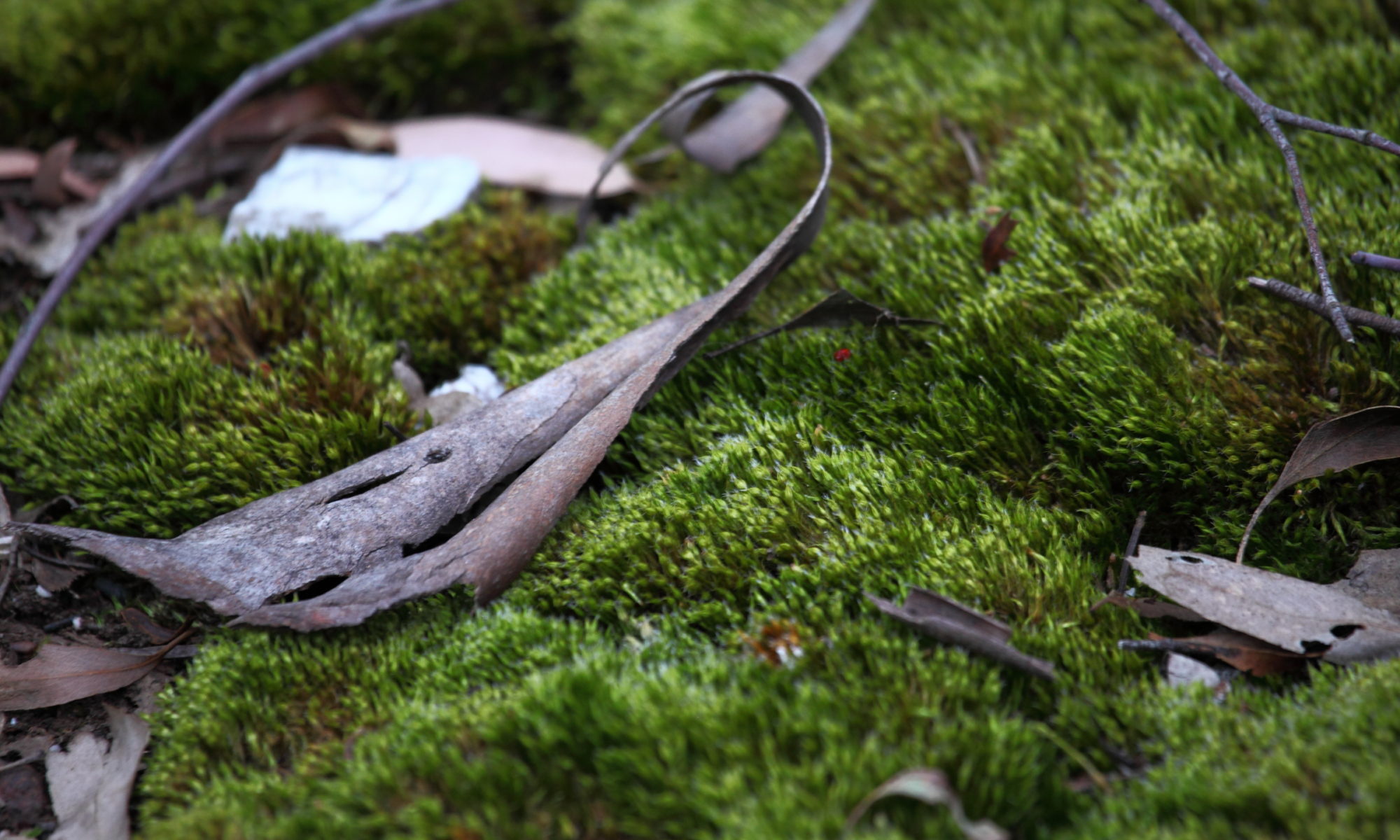We are having some technical issues here getting our videos uploaded to youtube. I was away working for a while and so missed a week but since getting back I have tried to upload clips but our internet keeps falling over. I hope to get this sorted out this week and catch up on what has happened in the last month. Mark
Nature, perfect one day, unpredictable the next
The great joy of my job is that Nature is so unpredictable. Its not just us humans that get it wrong but sometimes animals and insects are in the wrong place at the right time or the right place at the wrong time too. Robert Burns poem To A Mouse puts it so well.
The best-laid schemes o’ mice an’ men
Gang aft agley,
An’ lea’e us nought but grief an’ pain,
For promis’d joy!
The Koala, these gum leaf munching machines are pretty laid back normally. They tend to be seen napping the days away comfortable in the fork of a tree. Not a lot happens in a average Koala’s day, but then life in the trees can have its moments. The poor male in this weeks clip was trying to nap, as Koala’s do and the sudden arrival of the strong winds certainly took him by surprise. He was suddenly in a forest washing machine, lashed by branches and foliage, even as his limb shook and swayed in the gale. He certainly had a tight grip with those sharp long claws.
I was keen to record the Lunar Eclipse. After all they are not that common and I had great plans for how I was going to show it. Well dense cloud put paid to that, I stayed up ever hopeful, after all if you don’t do the time, you will never get the shots you want. It was freezing cold, windy to boot and oh so much cloud. In the end I admit I gave up at about 3am having not seen the moon for about 4hrs and it had well passed totality. Next time perhaps.
I did get all excited about the ants. If you have never seen Alates swarm it is a pretty amazing process, they erupt into the air from their holes in spectacular fashion, almost as if they were being flushed out of their holes by a leaf blower. I must admit I was pretty excited to see the build up to this happening and had all the gear ready to go. But they came, they tested the air and returned to their holes. Perhaps I will see it happen, I am certainly keeping watch on the ants in the evenings. Fingers crossed.
And then dumb luck, I find a Large Phasmatid, or stick insect. This is one big bug, she is a whopper, 200mm body length, and then all legs. I am trying to identify her but it is not easy. I am certain she is a she, females have short wings and cannot fly. There is no way this girl could fly with the wings she has. I found it really interesting that she only moved when the wind was blowing and the tree moving. In still conditions she just sat still, smart defense, only move when the other sicks are moving. It sure makes it hard to film as she does nothing when the tree is still, not even feeding.
Hope you enjoy this week, remember to subscribe to this blog if you want notification whenever I post. Remember this is a work in progress and I would appreciate any feedback you care to give, lets make this as good a site as we can. Cheers for this week.
A Day from Above
Something a little different this week. A Day from Above is a birds eye view of a summers day at my place in the central highlands of Victoria, Australia.
Starting with a misty foggy dawn moving through the heat of the day to sunset the flying camera explores my place and gives you an overview of the surrounding area. Shot over several days to give a representative overview of a typical summers day. From a misty foggy dawn, it soon heats up to the mid 30’s and inside the forest all is still and quiet. Late afternoon it starts to cool then ending after sunset where even in mid summer it can get quite cold in the evenings.
I hope you enjoy the overview of my place in the world and now have a better idea of a sense of place when viewing this clips from week to week.
For those interested, all the material was shot from a DJI Marvic Pro drone in 4k (thanks Micheal). I am a big fan of small drones and while they do have some limitations they are wonderfully able little devices and allow you to fly under the canopy and closer to the ground if you wish.
After much thought I decided to go with no commentary and just let the pictures talk, I hope you like it and let me know what you think.
Apologies for the delay in getting this out. We have had some tech issues that held things up but we are all sorted now.
A White Kookaburra and Cockatoos
What an exciting week it has been and it just goes to prove no matter how long you work with wildlife there are always some massive surprises to be had. That the nature world still astounds me is why I so love what I do.
I was so excited to see Snowy the White Laughing Kookaburra, even as I write I am still in awe of coming across such an amazing bird. My initial thought was that Snowy was an Albino. But after some fairly careful research and having a good look at the shots and zooming in on the eyes they look just like adult Kookaburra eyes, in that they are quite dark and they are not pink or light colored. So I think Snowy is not a Albino but has Leucism. Something I had no idea about until I looked into how Snowy is white.
So what is the difference between Albinism and Leucism?
When a bird is a true Albino, a genetic disorder causes the bird to not have the amino acid tyrosinase present in its system and so its body does not produce melanin pigments at all.
In the case of Leucism, the amino acid tyrosinase is present and so are the melanin pigments but in this inherited disorder the deposition of these pigments is blocked and so color is not transferred to the feathers, beak and skin scales in extreme cases.
So leucistic birds always have colored eyes which distinguishes them from albinos, as in the case of Snowy.
My source for this information is found at Not every white bird is an albino: sense and nonsense about colour aberrations in birds a paper by Hein van Grouw. Thank goodness for Google Scholar.
I do hope the white Laughing Kookaburra (AKA Snowy) does well and survives. Being such a standout creature will likely make its life hard and logic tells me without camouflage it will be a sitting duck for predators. Snowy lives on private land and without disturbance hopefully will live a long successful life, but only time will tell.
It is worth remembering that every animal is a individual, they all have their own personalities and characteristics. Some have obvious differences, like Snowy but anyone who has owned pets, (dogs, cats, birds or reptiles) knows that each one has its personality and is different and unique in its own way. This blog is a lot about celebrating the animal characters that live and pass though my life here. I look forward to your comments and subscribe to get reminders for every new post.
A white Kookaburra, you just never know what you will find in the natural world, do you.
Ethics and Film Making, My Rules
For all aspiring film makers and also for viewers of our content here is my guide to the ethics of filming wildlife. These are my rules and how I operate I think they are reasonable and will gladly hold to them for all my filming for this Blog.
1. Remember it is only a movie/photo, it is not ethical to make any creature miserable just to get your shots. So keep your distance, take your time and be aware of your effect and presence on the creature. I have a simple rule of thumb here, a happy animal does their own thing and that is often what you want to film/photograph.
2. If you film in controlled circumstances and by that I mean a set, tank, a zoo, a wildlife park etc say so. For some things we will work in controlled environments but we will always say so and tell you why it is necessary. (More about set filming later)
3. Do not create unreal scenarios or scenes that would not happen in nature. For example a polar bear eating penguins. (Think about it).
4. Leave nothing but footprints and take noting but images. That is do not destroy or damage the environment you are working in. No litter, no gaffa tape, when you leave, leave no trace of your visit.
5. Do it right, get all permissions and permits before you film/photograph. To conduct any commercial operation, that means to take video or photograph you might sell, in a National Park or reserve you need a permit from the relevant authority. Permits come with conditions that need to be read and understood and kept to. On private land make sure you have the approval of the land holder. Remember in all cases, you never know when you may need to come back so ensure you keep to the rules. (If you are just a tourist and capture something amazing you might be able to sell, most authorities will be understanding and look to issue a permit after the event if your honest and upfront. Plus they will probably be excited to see what you have done too)
6. I always remember taking movies or photographs in nature is a privilege not a right. I think it is the best job in the world but it does come with responsibilities to your subject and the environment they live in. Respect everything and keep yourself real and have fun.
A Shower of Rain, Koala and Glorious Stars
A brief respite in the summer heat and a few drops of rain raised spirits and gave the whole environment a chance to draw breath.
There is nothing like the smell of summer rain in the Australian bush. It is a heady smell of freshness and eucalyptus unique to the Australian bush, hard to describe but it raises the spirits and the whole environment seems to heave a collective sigh of relief. Although we only had some brief showers the light rain refreshed everything, humans, plants and animals alike.
We had a visit from one of our local male Koalas. His territory overlaps our place here and he is a regular visitor. Koalas can be very hard to see and find which is surprising given their size. But tucked in against a tree trunk or when they get up in the canopy they are so hard to spot. It is nice to be able to show him being so active, during the day they tend to just sit, especially in the heat of summer. At different times of the year they feed on different trees. Over the last few months I have noted they were feeding on Messmate stringybark, Eucalyptus obliqua. The Manna Gums, Eucalyptus viminalis have just started putting on new growth and so I guess he is after the fresh green foliage so this likely accounts for the shift in diet. I enjoy seeing and noting changes like this as it gives you a understanding of how all the environment is connected together, a sum of lots and lots of smaller parts and actions.
This male was nice and close to the house so was spotted as he moved about, otherwise finding a Koala is a lot like looking for a needle in a haystack, too many trees and very few animals. As far as I can tell the population here, while small, is pretty stable and sustainable. If you live in the Central Victoria there is an active monitoring project where you can log a Koala sighting and I encourage you all to do so. Macedon Ranges Koala Project It is a great way of monitoring our populations and participating in citizen science and the sight contains a wealth of local Koala information.
Finally to the stars. We had a run of clear nights here and I needed no excuse to timelapse our wonderful night skies. Each shot essentially runs for an entire night so while time consuming the results I think are spectacular. The Milky Way and Magellanic Clouds are spectacular at the moment and make it worthwhile going outside and just looking up once the sun sets on clear nights. Our altitude here, 600m (just under 2000ft) means we are often get clearer skies and great views of the stars. So enjoy our night skies of January. Until next week.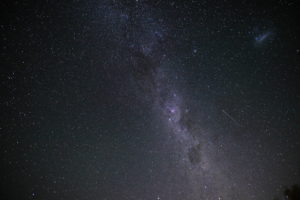
Scorching heat, Kangaroos & Echidna
Well there is only one word to describe last week and that was hot. Summer really is here now in the Central Highlands of Victoria, Australia.
The one thing you can be sure of when you get one of those windy scorching hots days is that you will find next to nothing in the heat of the day. But come late afternoon and evening the creatures start to emerge. Just about the first thing on their mind will be water, so I went down to dam, parked myself and camera and just waited quietly. It was well worth it, lots of things came in to the water but the family of Eastern Grey Kangaroos took the prize this week. They were so thirsty, and just looked at me and the camera on the far bank and went straight down to drink. They drank and drank, until the tiny grey fantail upset them that is. The sudden movement and sound turned their heads triggered the flight response and off they went. I can just imagine all that water sloshing about inside as they hopped, I wonder if it is uncomfortable? That is the sort of stuff that comes into my head while filming, odd isn’t it.
I was also lucky to find an Echidna. We seem to have several here, I have seen two individuals this week, the one I filmed and a much larger one just on dark the other night too. I hope over the next few months we will see some more Echidna antics.
Finally this week I have added a subscribe link on the blog page. So if you want an email for each new post please subscribe and also feel free to make comments too. Until next week.
The tips and tricks of how I filmed Spikey, the Echidna today
Well today I got lucky and was able to film an Echidna just doing its thing wandering about the forest and feeding. While I was out I got to thinking that this would make a good behind the scenes post.
So how do you film an Echidna? Very carefully, boom boom. Seriously the approach to getting close and filming most mammals is essentially the same. The upshot is you just need to become a non threatening part of their environment, that is become something they ignore and see you are not something to fear. But how do you do this? Don’t animals just run away? Well yes, but also no sometimes if you are lucky, careful and follow the rules you can literally get closer than your minimum focus. (at which point you just stop work and enjoy the moment.)
Ok, my basic ground rules are.
1. Do not stalk or try to sneak up. All wild animals are way more alert and in tune with what is going on around them than we stupid humans. Most of the time they will spot you long before you spot them. If they feel “hunted” even just for a photo they will run or in the Echidnas case, dig in and bury itself.
2. Move slowly, openly and never straight towards the animal and only when they can see you. No surprises. I usually walk in at about a 45 degree angle in the same direction as the animal is traveling so we would converge eventually. More often than not talking quietly to the animal. The logic behind this is the animal must think, “he is not following me and is not interested in me. He can’t be hunting me because he is making noise and seems focused on something else”.
3. Avoid eye contact. You want to keep the impression that you are just another creature sharing the same space. That your focus is not the animal, a glance yes, but only a glance especially in the early stages when you first make contact.
4. Let the animal come to you. Put yourself ahead of the animals path, don’t hide, just sit or stand and ignore the approaching animal. Talk to your self or the animal. Remember rule 3, feign disinterest.
5. RELAX. Chill out, don’t get excited, stay loose and relaxed. Remember move slowly at all times, never any sudden movement, enjoy the moment. Watching ants is always a good tactic to you appear not to be focused on the animal you are trying to share a space with.
6. Take your time. It will take as long as it takes but once the animal seems happy, ie not watching you, basically ignoring you, you can slowly start to film / photograph the animal and move with it. Again remember stay relaxed, move slowly and keep talking. You can end up way closer than you might think possible.
Just remember, it is up to the animal to accept you into their space, the choice is always theirs so respect that and don’t push and take your time. If they show signs of stress, back off and leave them alone, everyone has a bad day. If the settle down don’t break the trust you have established, it is so easy to go from hero to zero with just one quick thoughtless movement. Once you have your shots let the animal just wander away from you before you move on.
So to today with Spikey the Echidna, I spotted it having a drink. I surprised it as I was not aware it was there and it immediately moved away and so did I leaving in the opposite direction to the Echidna. I noted its direction of travel and then hightailed it off (walking slowly) for the camera gear. When I came back, about 10min later, I approached from a totally different direction ie from where I saw the Echidna heading. I spotted it and immediately stopped and let it see me, talking quietly. It came to within about 15m of me and veered away and around me, but still heading in the same basic direction. I let it move about 25m away to where I could barely see it. Then moved slowly out and ahead if its path again so it could see me. This time it came closer, before veering away but I could tell I was winning. This process happened several times more, each time it came closer than the last and was more relaxed. I was able to move position in plain sight of the Echidna and it just kept doing its own thing. All the time I am talking, making sure it knows where I am, and where necessary watching ants to chill out. This is where experience comes in, I could see the point it had accepted me as a neutral part of its landscape. It had taken about an hour and a half, but now I was able move at will, never straight toward the Echidna but into its path. Every move it came closer and closer before angling away. Finally it came under minimum focus and straight past the tripod, totally ignored by me. This is the magic moment you hope for. All done with a little time, patience and gentle persistence.
I then stayed with Spikey until he/she went through a fence. I had more than enough shots and called it a day letting the Echidna wander off before I moved away. What a thrill, trusted by a wild animal with a ticket to its world for a couple of hours. Days like today leave me feeling so good, it is why I love what I do. Thanks Spikey, see you again sometime soon I hope. Stay safe little friend.
Behind the Scenes: Macro filming in the field
Here is how I filmed the macro shots in this weeks video in the field. This pretty much is my standard way of doing similar sorts of shoots where it is impossible to move the subjects to a more sheltered location.
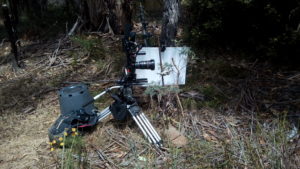
The shoot days were pretty breezy and that made filming the macro shots very tricky, even tiny movements end up looking like earthquakes when you are using high levels of magnification. Even just the ants moving were causing problems with the branch bouncing up and down and when the wind blew it was next to impossible to get a steady shot.
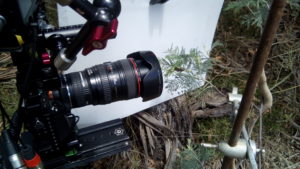
The photo shows my setup. I used a heavy lab stand and clamp to steady the branch the caterpillar was sitting on. Initially this disturbed the ants but after a few minutes they settled back down as if nothing had happened. The second tip was to use a rigid white piece of cor-flute board to the windward side of the area I was trying to protect. This left a small pocket of stiller air most of the time and had the added advantage of bouncing some extra fill light back into the scene too. (If you dont want the fill just use a matt back board)
The macro shots used my trusty Canon MP65, it covers the range of 1:1 to 5:1 in macro in one neat lens package. (To explain further, 1:1 to 5:1 refers to magnification, so at 1:1 the image on the camera sensor is the same size as the subject. At 5:1 the image on the sensor is 5x magnified ie larger, that the actual subject. That is how you can see an ant only 3mm long in so much detail.)
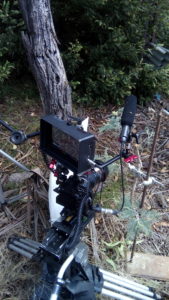
The other essential piece of kit is the slide plate between the camera and tripod. The lens does not focus as like a normal lens, you turn the barrel to change magnification (not to focus) and to actually focus you slide the whole camera rig toward and away from the subject. It is fiddly but also very satisfying to see things to small to normally observe.
I hope you like these insights behind the scenes and feel free to ask me any questions you may have and I will do my best to answer them for you.
Caterpillars, Butterflies and Ants.
What caught my attention this week was a lovely symbiotic relationship between caterpillars, pupae, butterflies and the ants that protect them. We are lucky enough to have several colonies of these living here.
The Supermoon on January second also had me out too, how could I resist playing with images of the moon and stars especially on summer evenings. (Ok the truth is it was cold, there were so many mosquitoes they would have eaten me alive except I was all rugged up and covered, but I still really love what I do.)
So this is what this whole project is about, just going out with the camera and filming week to week things here that I find interesting and bringing them to you. I truly hope you find the wonders of nature as amazing as I do.
